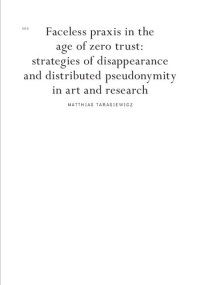
Ebook: Faceless praxis in the age of zero trust: strategies of disappearance and distributed pseudonymity in art and research
Author: Matthias Tarasiewicz
- Tags: bitcoin blockchain crypto cryptoeconomics privacy security faceless parasew riat
- Year: 2018
- Language: English
- pdf
We live in times of “zero trust” (Western, 2013), a term stemming from computer security research, which is “applied to all sectors and businesses”. Most prominently zero trust is used in cryptoeconomic systems such as Bitcoin and other Blockchain-based technologies - describing the practice to “never trust, always verify” (ibid). This ‘computational trust’ applies the human notion of trust to the digital world, that is seen as malicious rather than cooperative. The term Faceless describes different forms of praxes, which can be read in relationship to the accelerated technological change affecting authorship, agency and production in the 21st century. While the concept of anonymity (namelessness) refers to the unknown identity,‘facelessness’ also includes pseudonymity, a disguised or obfuscated entity which also points to leaderless organisation and non-human (AI) or distributed collective agency between humans and machines on the example of distributed autonomous organisations (DAOs). Technology-based and formerly called ‘new media arts’ can act as a shield and as an encrypted (obfuscated) basis to test and deploy subversive or sub-versioned (critical) research and practice.
Download the book Faceless praxis in the age of zero trust: strategies of disappearance and distributed pseudonymity in art and research for free or read online
Continue reading on any device:

Last viewed books
Related books
{related-news}
Comments (0)